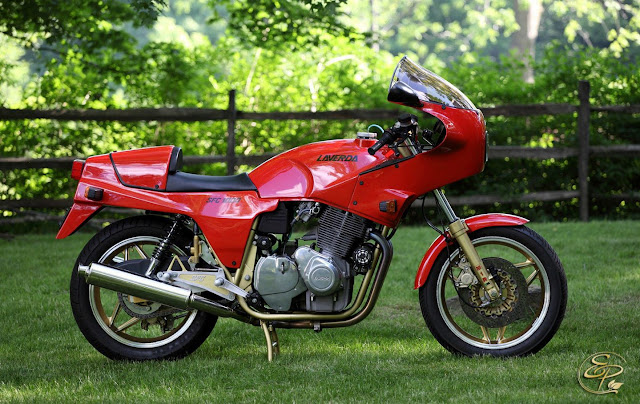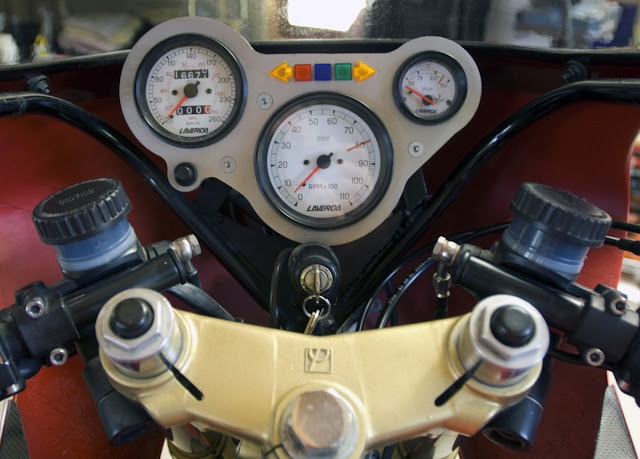Laverda SFC 1000
The SFC's rather tall look hinted at its 1970s origins, but the half-fairing, generous screen and roomy riding position also made the bike comfortable for high-speed cruising. Having lost some of the original triples' raw character with preceding models in the 1980s, Laverda was careful to keep the handsome aircooled engine visible.
Laverda’s powerful air-cooled triples had been some of the fastest and most glamorous superhikes of the 1970s, but during the following decade the Italian firm lacked the financial resources to develop an equally competitive successor. Instead, the triple was restyled and refined to produce a more modern and sophisticated series of machines, the last and best of which was the SFC 1000.
With its tall half-fairing blending smoothly into the fuel tank, below which sat a familiar 981cc three-cylinder engine, the SFC was a direct development of the RGS 1000 model with which Laverda had begun its new generation of triples in 1982. In contrast to the loud, raw earlier triples such as the Jota, the RGS had a slightly softer, more flexible engine whose more restrictive exhaust system enabled the bike to pass stricter noise regulations.
Updated image
The RGS had succeeded in giving Laverda a more modern image for the 1980s. but had lacked both the all-conquering speed and the raw character that had traditionally attracted the marque’s enthusiasts. In 1984 Laverda had added some performance with the RGS 1000 Corsa whose engine, tuned with high-compression pistons, new valves, modified airbox and revised exhaust system, increased peak output to about 90bhp.
For 1985 Laverda used the Corsa engine as the basis of a new model, the SFC 1000. Its name was designed to bring to mind the thunderous 750 SFC production racer of the 1970s, although in reality the new' triple was a modified Corsa with red instead of black paintwork, subtly reshaped fairing and tank, and some new cycle parts. Its tw in- downtube steel frame w;as identical except for its gold finish, and held a new box-section aluminium swingarm. Other new parts included the rearset footrests, cast alloy wheels, plus Marzocchi forks and remote-reservoir rear shocks.
With its high tinted screen the SFC was tall by 1985 standards, its air-cooled engine was undeniably outdated, and it was heavy at 538lb (244kg). Inevitably the stirring three-cylinder bellow of old was stifled by emissions regulations. But despite that the big Laverda was a good-looking and distinctive machine that had enough pace and character to get its rider’s adrenaline flowing.
The engine sometimes felt rough at very low revs, but once into its stride the SFC was tractable as well as powerful, pulling smoothly all the way from 3()()0rpm to a top speed of 140mph (225km/h). In corners the big Laverda could not match the best Japanese bikes in terms of agility or grip from its unfashionably narrow 18-inch tyres, but it was still very enjoyable. Its Marzocchi suspension was firm and well damped: the Brembo Gold Line brakes gave superbly powerful stopping.
Although the SFC was far from being a competitive super-sports machine, it combined its performance with enough comfort to make it an excellent sports-tourer. There was potential for more speed, too, as the factory offered a sports kit of three-into-one exhaust system and larger main jets for the Dell'Orto carburettors. Really serious owners could opt for the racetrack kit comprising hot cams, valve springs, bigger 36mm carburettors and close-ratio gearbox.
Laverda had been planning to build only 200 units of the SFC 1000 before moving on to produce a more modern range of three-cylinder middleweights. But the firm's financial problems meant that the new bikes never appeared, and the final batch of SFC 1000s left the factory at Breganze in 1987. Laverda would be revived in the 1990s under new ownership - with a range of parallel twins. The story of the famous air-cooled triples had come to an end.
This Laverda m gl t have been expensive, and uncompetitive with the latest Japanese superbikes but this was still a very stylish machine that turned heads, had heaps of character and generated adrenaline by the bucketful.
The 981cc aircooled dohc three-cylinder engine incorporated a few refining touches that had
Twin rear shock absorbers and 18-it:, wheels were old-fa ot by the time the SFC appeared in 19s' r its reasonably
Specification Laverda SFC 1000 (1985)
- Engine Air-cooled dohc six-valve triple
- Capacity 981 cc (75 x 74mm)
- Maximum power 90bhp @ 7000rpm
- Transmission Five-speed, chain final drive
- Frame Steel twin downtube
- Suspension Telescopic front; twin shocks rear
- Brakes Twin discs front; disc rear
- Weight 538lb (244kg) wet
- Top speed 140mph (225km/h)























0 comments: